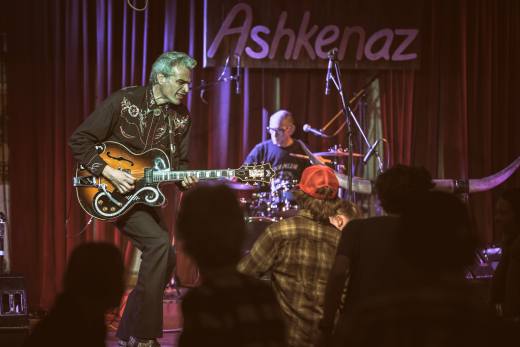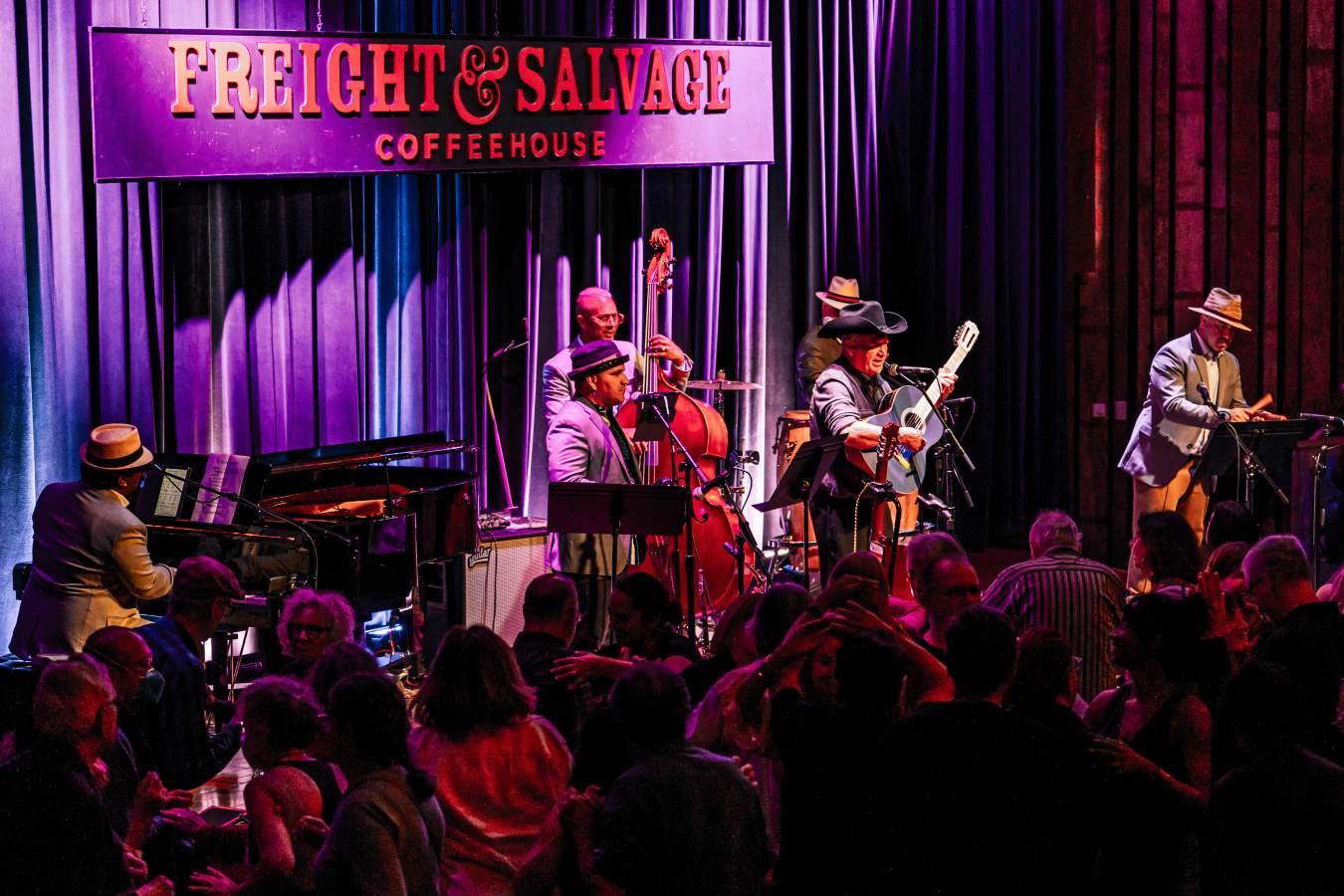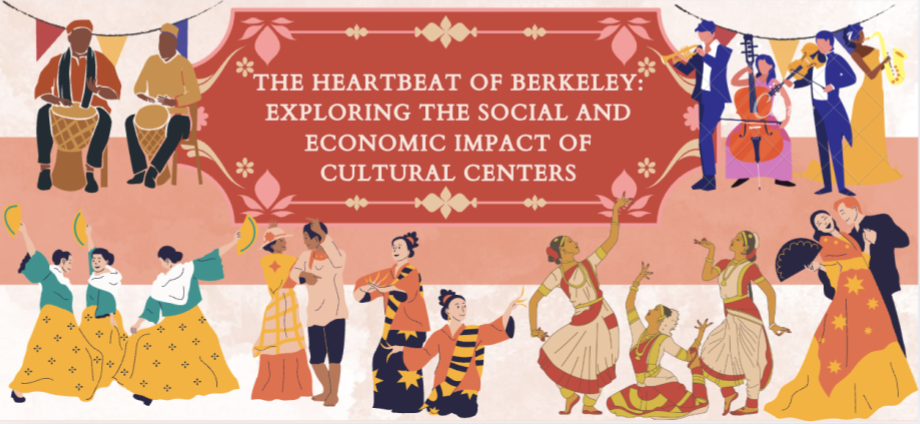Author: Bani Singh, Graphics: Cindy Chen
Berkeley has been home to various cultural centers throughout the decades which have all helped shape the progressiveness and diversity of the community. However, since many operate as local nonprofit organizations, they often face financial difficulties and setbacks that put these organizations at risk. Though its important for residents and visitors alike to be aware of the cultural value provided by these centers, it’s also crucial to understand how to support these spaces so that they are preserved for years to come.
A Vibrant Cultural Scene
The thriving cultural position of Berkeley plays a significant role in shaping its reputation as one of the most progressive cities in the world. The city is a melting pot of communities, offering a rich tapestry of artistic expression, political/social activism, innovation, and history that draws a variety of individuals to live and travel here. According to a population data report collected earlier this year, the demographic composition further showcases the city’s ethnic/racial diversity, with White Americans making up roughly 54.8% of the population, Asian Americans representing 20.7% of the population, followed by Hispanic Americans comprising 12.1%, and African Americans making up 7.54%.
This diversity is substantially because of the presence of the University of California, Berkeley, whose student population reflects the ethnic makeup of the city and also incorporates international students, who account for 16.2% of the student body. In addition, the university has played a pivotal role in shaping the progressive ethos of Berkeley, fostering an environment that champions social justice, activism, and inclusivity.
The birth of the Free Speech Movement in the 1960s, for instance, was a student-initiated protest to ensure students’ right to free political speech. Bridge these two sentences with more of the history and examples of the free speech movement. The activism rooted within the campus continually influences the political landscape of Berkeley, promoting progressive values that resonate within the city today.
The people, therefore, serve as a catalyst for cultural exchange and dialogue, enriching the community as a whole. This is also evident by the presence of cultural centers and organizations that promote the arts and culture of the community by hosting various events, workshops, exhibitions, and spaces for individuals to engage in, which allow community members to connect with each other. It is also noteworthy to mention that many cultural centers happen to be nonprofits as they aim to serve the public good rather than to economically benefit. Specifically, these organizations are classified as 501(c)(3) nonprofits of the Internal Revenue Code, exempting them from federal income taxes as they benefit the community in some charitable, religious, educational, scientific, or other way. However, these organizations face many financial hardships as they must balance their commitments while also trying to remain financially viable. These difficulties present a challenge in terms of the long-term sustainability of such centers, despite how vital they are for providing spaces for community engagement.
Therefore, in a city such as Berkeley which is renowned for its diverse population and progressive values, the importance of its cultural centers should be made known to residents and visitors so they may gain a deeper appreciation for the experiences that Berkeley has to offer and the ways they can support their continued existence.
Heritage and Social Justice
La Pena Cultural Center
The La Pena Cultural Center is a social justice-focused organization in Berkeley that was founded in 1975 in response to the Chilean military coup that overthrew the socialist government of Salvador Allende. It provided a safe space for community gatherings and activism as part of the anti-Pinochet movement in the United States. While it started as somewhat of a political center, it continues to run today, presenting a wide variety of events including concerts, community gatherings, theatre performances, art exhibitions, and more with a focus on displaying the arts and progressive movements of the Americas. It also provides daily classes and workshops rooted in preserving Latinx and Caribbean cultural traditions.
The nonprofit organization relies on a mix of donations, grants, and fundraisers to compensate for its operating expenses. At the end of 2022, they launched an exciting new membership program that provided exclusive tickets to their highly sought-after events for a monthly fee of $20. This includes access to their “Baila!” dance parties which are typically celebrated a few times a year. This demonstrates their attempt to generate revenue from their popular events. However, in recent times the center has been in “emergency mode” as a result of diminishing funds. At the end of 2023, for instance, they had a budget deficit of more than $128,000. This financial shortfall was attributed to total revenues amounting to $750,914, which fell short compared to their total expenses of $879,639. This isn’t the first time the organization has dealt with financial problems, and it aims to rebuild through grants, fundraisers, and other strategies. Most importantly, however, the center is committed to maintaining its cultural values and providing a space for the community.
Ashkenaz Music & Dance Community Center
Known as Ashkenaz, the 50-year-old music venue and dance hall provides a center for participatory dance and music rooted in traditional cultures worldwide. The establishment’s eclectic lineup showcases performances and events from a wide variety of genres and cultures. One can experience the rhythmic beats of African music, Balkan tunes, Brazilian genres, American roots and so much more. The organization’s efforts in fostering a space to celebrate a wide array of music groups and individuals have contributed to its recognition as the Best Dance Club in a 2023 poll evaluating various East Bay centers.

More than just a music and dance venue, however, Ashkenaz is a center for activism and social justice as well. In honor of his Ashkenazi Jewish ancestors, human rights activist David Nadel founded the organization in 1973 to promote international folk dance. Upon his murder in 1996, activists, in collaboration with other community members, came together to form Ashkenaz as a tax-exempt nonprofit organization in order to continue Nadel’s legacy. To this day, Ashkenaz continues to provide a place for social justice issues and to promote multiculturalism despite prevalent racial and ethnic tensions.
As an internationally recognized nonprofit, the organization is heavily reliant on community support for its services such as events, festivals, and classes that are available for purchase to the public. Grants and other contributions also allow Ashkenaz to sustain its mission. Yet, the center reported a $31,161 deficit in a recent fiscal year, highlighting the ongoing need for increased community and financial support to ensure that Ashkenaz can maintain its operations and serve the public effectively.
Artistic Innovation
Many cultural centers are often established with a specific ethnic focus, aiming to celebrate and preserve the traditions of particular communities and groups. There are also various organizations, however, that are created to uplift artistic expression as a whole rather than focusing on any one specific cultural origin, especially as art, music, and theatre play a significant role in spreading cultural awareness.
Berkeley Art Center
The Berkeley Art Center is a vibrant hub for contemporary art dedicated to enriching the cultural landscape by providing the city’s diverse communities with exhibitions, art events, art workshops, and more. Not only that, but the center specifically aims to advance its opportunities for Black, Indigenous, and People of Color (BIPOC), queer and trans people, and people living with disabilities, especially as it acknowledges its geographic location in red-lined neighborhoods that have historically excluded these members of these groups. Their efforts in offering accessible events ensure that the organization is not only welcoming but also reflective of the diverse community it serves. By offering programs and resources tailored to the needs of these groups, the Berkeley Art Center fosters a rich artistic expression and cultural dialogue that makes it a popular and impactful center in the city.
As another nonprofit organization, its total generated yearly revenue of $385,937 exceeds its total expenses by only roughly $15,000. Much of its funding comes from grants from other foundations and nonprofits, as well as general program services and donations.
Freight & Salvage Coffeehouse
The Freight & Salvage Coffeehouse is a community arts organization founded in 1968 that provides a space for traditional, ethnic, and regional music. During a time of anti-establishment policies and racial and gender inequality, the center was created to provide a space where diverse people could gather together for their artistic pursuits. Now it has become a cultural landmark for upcoming artists to showcase their talents and for experimental music in general.

The nonprofit organization continues to generate its funding through ticket sales for music-related events and performances, memberships, grants, and donations. Beyond the conventional performance venue, the center plays a major role in the local music scene of the Bay Area by hosting open mic nights to encourage aspiring musicians. It also organizes its annual Freight Fest, a music festival, to promote local artists and community engagement overall.
However, like other nonprofits in the area, Berkeley’s Freight & Salvage has been bouncing back from significant financial losses. In the 2023 fiscal year, for instance, the organization faced a budget deficit of roughly $940,000, with total expenses of $5.9 million exceeding the generated revenue of $4.9 million.
So Why Should We Care?
Cultural centers have an impact on ordinary citizens by highlighting various groups and accurately portraying cultural diversity, which promotes inclusivity and helps society unlearn toxic beliefs about underrepresented groups.
These organizations are also simply essential in building community, as they bring people of similar backgrounds together to celebrate their shared experiences, traditions, and more. In these spaces, individuals have a sense of belonging, which enhances their well-being in light of the challenges or obstacles they may face. This is the power that cultural centers have.
Financial Realities of Local Nonprofits
Yet, despite the importance of cultural centers in long-term community enrichment, in terms of economic and financial development, these organizations often face many challenges. All of the mentioned nonprofit organizations have faced significant deficits, as their total expenses exceed their generated revenue. Several challenges contribute to this issue, such as funding limitations, competition for grants, and the necessity to attract diverse audiences, which are just a few of the obstacles that local nonprofits must overcome.
This differs greatly from national/larger nonprofits, which tend to have greater reach and resources, especially as they have multiple chapters and professional employees across the country. As a result, this allows them to receive more contributions. In addition, large nonprofits have greater recognition, granting them more access to donors, especially as nine out of ten donors form their perceptions of nonprofits based on size. Furthermore, these organizations gain their size through effective funding models as well. Specifically, 90% of nonprofits with $50 million or more in generated revenue concentrate on their dominant revenue category, rather than diversifying their funding sources.

However, the comparisons between national and local nonprofits do not undermine how integral community-based grassroots organizations are. Cultural centers contribute significantly to Berkeley’s economy by monetizing popular events and activities, improving support for local businesses, and employing community members for the functionality of their organization.
Strengthened Community Support
Cultural nonprofits depend heavily on loyal local audiences and patrons who recognize the cultural and societal value these centers provide. As tax-exempt organizations classified under 501(c)(3), donations are tax-deductible, making donors more likely to contribute.
Furthermore, organized events not only serve as opportunities for community engagement but also double as fundraisers that help sustain the operations of the center. For instance, Ashkenaz often hosts celebratory events such as the 50th Anniversary festival, selling tickets to showcase several events of international music and dance.
All in all, residents and visitors of Berkeley should take some time to take a dance class, visit an art show, and simply explore the local spaces that enrich this vibrant city so much! Those who feel inspired should even consider making a donation as well. Any kind of contribution is impactful, allowing these centers to sustain themselves and therefore do what they do best, enhance the community.
Take-Home Points
- The diversity and history of Berkeley have made it one of the most progressive cities in the world.
- Cultural centers that promote art and inclusivity through their various events also contribute to the development of Berkeley’s community.
- Certain centers such as the La Pena Cultural Center, Ashkenaz Music & Dance Community Center, Berkeley Art Center, and Freight and Salvage Coffeehouse have all had a unique impact on the city by hosting events and creating spaces where individuals from various backgrounds can socialize and collaborate with other community members.
- Many cultural centers are classified as 501(c)(3) nonprofit organizations as they aim to serve the public good rather than make a profit, however, they often face financial challenges while trying to maintain operations.
- Community members can support these centers by simply visiting them, attending events, participating in fundraisers, and even donating, especially as these nonprofits are tax-deductible.

